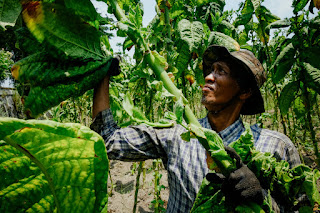
Tobacco is the common name for several plants in the genus Nicotiana of the Solanaceae family, as well as the umbrella term for any product made from the cured leaves of these plants. There are over 70 tobacco species known, but the most important commercial crop is N. tabacum. N is the more potent variant. In some countries, rustica is also used.
Tobacco contains both nicotine, a highly addictive stimulant alkaloid, and harmala alkaloids. Tobacco use is a cause or risk factor for a wide range of fatal diseases, particularly those affecting the heart, liver, and lungs, as well as many cancers. Tobacco use was named the world’s leading preventable cause of death by the World Health Organization in 2008.
Dried tobacco leaves are primarily used for smoking in cigarettes, cigars, pipes, and shishas. They are also available in snuff, chewing tobacco, dipping tobacco, and snus form.
The tobacco epidemic is one of the most serious public health threats the world has ever faced, killing more than 8 million people each year, including approximately 1.2 million deaths from second-hand smoke exposure.
Tobacco in all forms is harmful, and there is no safe level of tobacco exposure. Cigarette smoking is the most common type of tobacco use in the world. Waterpipe tobacco, various smokeless tobacco products, cigars, cigarillos, roll-your-own tobacco, pipe tobacco, bidis, and kreteks are examples of other tobacco products.
Over 80% of the world’s 1.3 billion tobacco users live in low- and middle-income countries, which bear the greatest burden of tobacco-related illness and death. Tobacco use contributes to poverty by diverting household spending away from necessities like food and shelter and toward tobacco.
Tobacco use has significant economic costs, including significant health-care costs for treating diseases caused by tobacco use, as well as lost human capital due to tobacco-attributable morbidity and mortality.
The smoke emitted from the burning end of a cigarette or other smoked tobacco products (such as bidis and water-pipes) and the smoke exhaled by the smoker constitute second-hand tobacco smoke. Tobacco smoke contains over 4000 chemicals, and there is no safe level of exposure to second-hand tobacco smoke.
The Conference of the Parties to the WHO Framework Convention on Tobacco Control (WHO FCTC) has concluded, based on scientific evidence, that 100% smoke-free environments are the only proven way to adequately protect people’s health from the harmful effects of second-hand tobacco smoke. Smoke-free laws are popular because they protect the health of nonsmokers while also encouraging smokers to quit.
Tobacco kills up to half of those who use it.
Every year, tobacco kills over 8 million people. More than 7 million of those deaths are caused by direct tobacco use, while approximately 1.2 million are caused by nonsmokers being exposed to second-hand smoke.
More than 80% of the world’s 1.3 billion smokers live in low- and middle-income countries.
In 2020, 22.3% of the global population, 36.7% of men, and 7.8% of women used tobacco.
In 2003, WHO Member States adopted the WHO Framework Convention on Tobacco Control (WHO FCTC) to combat the tobacco epidemic. This treaty has currently been ratified by 182 countries.
The WHO MPOWER measures are consistent with the WHO FCTC and have been shown to save lives as well as reduce costs associated with avoided healthcare expenditure.
Tobacco taxes are the most cost-effective way in many countries to reduce tobacco use and health-care costs, particularly among youth and low-income people, while increasing revenue. The tax increases must be significant enough to cause prices to rise faster than income growth. Tobacco price increases of 10% reduce tobacco consumption by about 4% in high-income countries and about 5% in low- and middle-income countries.
Tax evasion and avoidance undermine the efficacy of tobacco control policies, particularly higher tobacco taxes. Tobacco companies and others frequently argue that high tobacco product taxes lead to tax evasion. However, experience from many countries shows that even when tobacco taxes and prices are raised, illicit trade can be successfully addressed.
When tobacco users learn about the dangers of smoking, the majority of them want to quit. However, nicotine in tobacco products is highly addictive, and without cessation support, only 4% of smokers who try to quit will succeed. Professional assistance and proven cessation medications can more than double a tobacco user’s chances of quitting successfully.







